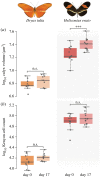Adult neurogenesis does not explain the extensive post-eclosion growth of Heliconius mushroom bodies
- PMID: 37885989
- PMCID: PMC10598442
- DOI: 10.1098/rsos.230755
Adult neurogenesis does not explain the extensive post-eclosion growth of Heliconius mushroom bodies
Abstract
Among butterflies, Heliconius have a unique behavioural profile, being the sole genus to actively feed on pollen. Heliconius learn the location of pollen resources, and have enhanced visual memories and expanded mushroom bodies, an insect learning and memory centre, relative to related genera. These structures also show extensive post-eclosion growth and developmental sensitivity to environmental conditions. However, whether this reflects plasticity in neurite growth, or an extension of neurogenesis into the adult stage, is unknown. Adult neurogenesis has been described in some Lepidoptera, and could provide one route to the increased neuron number observed in Heliconius. Here, we compare volumetric changes in the mushroom bodies of freshly eclosed and aged Heliconius erato and Dryas iulia, and estimate the number of intrinsic mushroom body neurons using a new and validated automated method to count nuclei. Despite extensive volumetric variation associated with age, our data show that neuron number is remarkably constant in both species, suggesting a lack of adult neurogenesis in the mushroom bodies. We support this conclusion with assays of mitotic cells, which reveal very low levels of post-eclosion cell division. Our analyses provide an insight into the evolution of neural plasticity, and can serve as a basis for continued exploration of the potential mechanisms behind brain development and maturation.
Keywords: Kenyon cells; neurodevelopment; plasticity; proliferation.
© 2023 The Authors.
Conflict of interest statement
We have no competing interests.
Figures




Similar articles
-
Enhanced long-term memory and increased mushroom body plasticity in Heliconius butterflies.iScience. 2024 Jan 18;27(2):108949. doi: 10.1016/j.isci.2024.108949. eCollection 2024 Feb 16. iScience. 2024. PMID: 38357666 Free PMC article.
-
Plasticity and genetic effects contribute to different axes of neural divergence in a community of mimetic Heliconius butterflies.J Evol Biol. 2023 Aug;36(8):1116-1132. doi: 10.1111/jeb.14188. Epub 2023 Jun 21. J Evol Biol. 2023. PMID: 37341138
-
A modified method to analyse cell proliferation using EdU labelling in large insect brains.PLoS One. 2023 Oct 5;18(10):e0292009. doi: 10.1371/journal.pone.0292009. eCollection 2023. PLoS One. 2023. PMID: 37796816 Free PMC article.
-
Behavioral functions of the insect mushroom bodies.Curr Opin Neurobiol. 2000 Dec;10(6):790-5. doi: 10.1016/s0959-4388(00)00147-1. Curr Opin Neurobiol. 2000. PMID: 11240291 Review.
-
The functional basis of wing patterning in Heliconius butterflies: the molecules behind mimicry.Genetics. 2015 May;200(1):1-19. doi: 10.1534/genetics.114.172387. Genetics. 2015. PMID: 25953905 Free PMC article. Review.
Cited by
-
Reduced Adult Neurogenesis in Humans Results From a Tradeoff Rather Than Direct Negative Selection.Bioessays. 2025 Sep;47(9):e70041. doi: 10.1002/bies.70041. Epub 2025 Jul 14. Bioessays. 2025. PMID: 40658885 Free PMC article. Review.
-
Enhanced long-term memory and increased mushroom body plasticity in Heliconius butterflies.iScience. 2024 Jan 18;27(2):108949. doi: 10.1016/j.isci.2024.108949. eCollection 2024 Feb 16. iScience. 2024. PMID: 38357666 Free PMC article.
References
-
- Meinertzhagen IA. 2001. Plasticity in the insect nervous system. Adv. In Insect Phys. 28, 84-167. (10.1016/S0065-2806(01)28009-6) - DOI
Associated data
LinkOut - more resources
Full Text Sources

